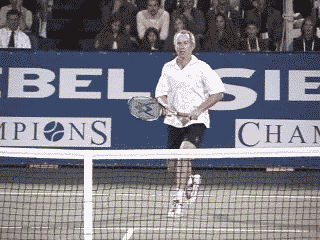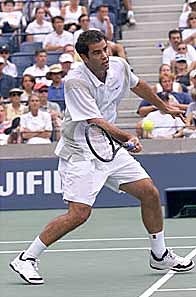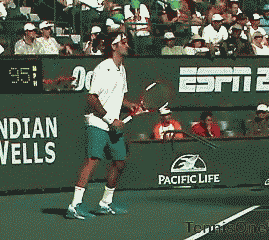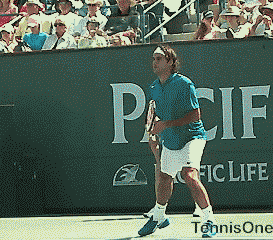|
TennisOne Lessons Back to the Basics, Part 2 Your 10 week Spring Training Program Jim McLennan This is a continuation of January’s article that introduced a three month “spring training program” in preparation for the upcoming USTA season. And though nearly all of us play tennis year round, and this includes both recreational, professional, and USTA league players, certainly April (or the last week in March) will introduce the next iteration of USTA adult competition. So to borrow the baseball analogy where teams assemble at this time of the year to refocus on fundamentals, I believe the same process can benefit you and me. In January, I asked you to work on your eyes and your point of contact. Much like the amazing Roger Federer, who seems to do everything well. This initial project was simply to make you continually aware of the location of your eyes when meeting the ball, and equally to make you continually aware of the location of the point of contact. Certainly keeping ones head still and meeting the ball out in front are pretty basic, but many times we overlook this in search of more elusive if not convoluted ideas. The hand, the Grip, and the Edges of the Racquet.
The shake hands grip, as I know it, is one where first the hand is extended as though ready to shake hands with another. The wrist is not flexed or extended; the palm is not up or down, but rather more or less vertical. Placing the racquet face against this palm, and carefully sliding the hand down from the face to the handle creates an eastern forehand grip. Without moving the hand about the handle, but rather turning the handle within the hand, a slight clockwise turn of the handle produces a continental grip (McEnroe). A slight counter clockwise turn of the handle produces a low eastern forehand grip (Federer or Sampras). A further turn in this direction produces a semi western grip (Agassi) and even more of a turn and you are using the western grip – though at this point in tennis history it might be more accurately known as the “Spanish Armada” grip. Truly, one can play the entire game with only one grip, but fluency with grips generally enhances ones ability to play more shots in more situations (and this sentence is likely to produce a flurry of email responses).
So if you hold the racquet in the eastern forehand grip, the racquet face is vertical if not ever so slightly tilted down (commonly known as a closed face), where the top edge of the racquet is in front of the bottom edge. If the racquet turns to the continental grip the lower edge of the frame is leading (open face). Spin accrues from the combination of the angle of the racquet face and the direction of the swing. So that topspin occurs when the top edge leads and the swing is low to high. Backspin occurs when the bottom edge leads and the swing is high to low. Exaggerating the edges, and or exaggerating the direction of the swing will produce greater amounts of spin. You can experiment with this on the ball machine. For example, move the grip to a semi western forehand (if you are not familiar with this) and note that initially the ball tends to go into the net, for the adjustment in the edges was not combined with an adjustment in the direction of the swing. But with a little tinkering, you can get the feel for this shot by moving the racquet up more forcefully at impact. And the reverse experiment is equally interesting. When volleying, move the grip (and the edges) so the racquet face is more open than normal, and now the ball goes much too high until you change the swing and move the racquet more forcefully down at impact, often creating a delightful chop shot. So where does this random thing fit in? I believe the best players at our club are the ones who can adjust their edges (and their swing) to volley when needed and to adjust their edges (and their swing) to groundstroke when needed. Not in a rigid pre-planned way, but rather on the fly, simply in response to the incoming ball. And those unwilling or unable to make these adjustments seem stuck in certain court positions, waiting for a shot that suits their edges. So here is the drill. Using your favorite practice partner, warm-up in “No Mans Land,” about five feet behind the service line. Exchange easy warm-up ground strokes, nothing fast or furious. And, because these are groundstrokes, lead with the top edge to produce gentle topspin. Back and forth, the normal recreational warm up. But often randomness enters the picture when either you or your partner lose control and hit the ball further than planned, such that the other must volley unexpectedly. The trick, the skill, and the next progression in your spring training is to adjust the grip and your edges to volley with the slightest under spin. Topspin groundstrokes, underspin volleys, all produced with a subtle adjustment of grip and edge. And here is another example. Generally topspin is used on aggressive swings when adding pace to the ball, for when hitting harder one needs more spin to bring the ball down after crossing the net. And generally, underspin is used when borrowing pace, when eschewing placement over power.
The maestro, Roger Federer, will often block the return of the first serve with the slightest under spin, simply borrowing pace and finessing the ball back into play. Conversely, Roger often drives the return of the second serve much more aggressively, using topspin. You can practice the same tactic with a practice partner. Block the return of their first serve (assuming it is fast) with the slightest under spin (remember edges and direction of swing) and drive the return of their second serve with over spin. What works for Roger will work for you, not quite as well but the general idea makes eminent sense. In March we will examine specific situations where all these things come together. Now back to work (on court). Your comments are welcome. Let us know what you think about Jim McLennan's article by emailing us here at TennisOne.
|
||||||||||||






